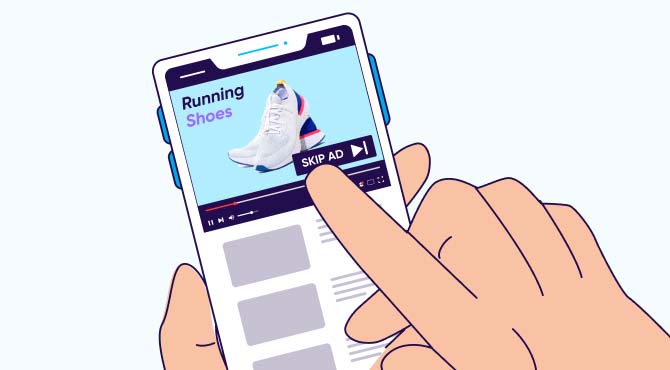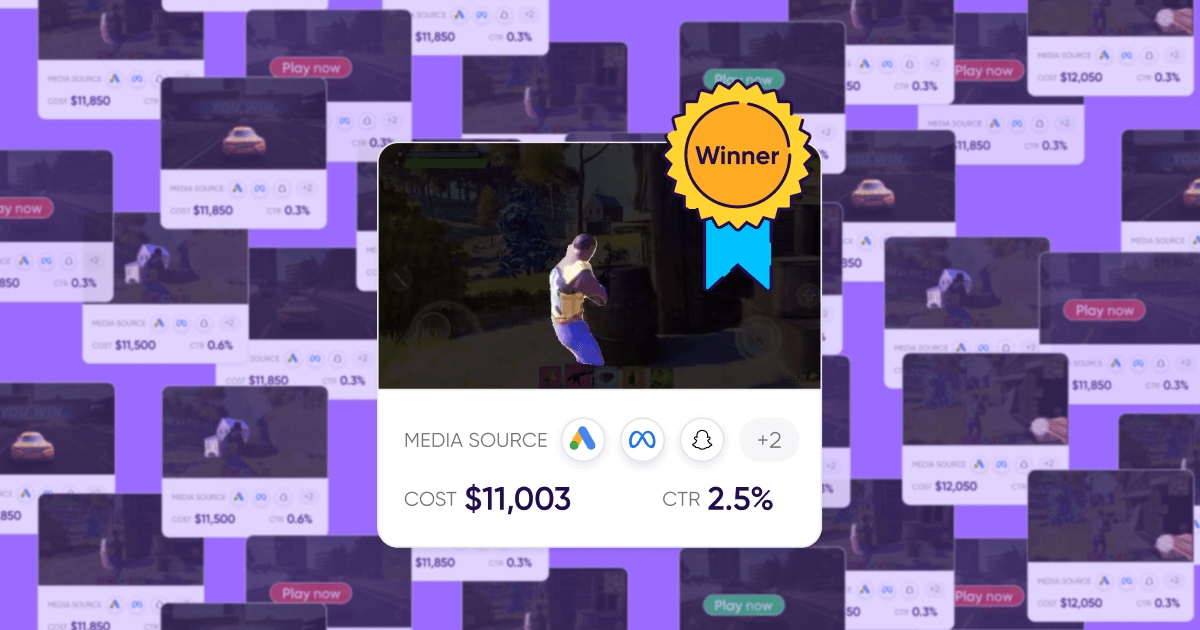
OTT (Over-the-top)
OTT (over-the-top) is the practice of delivering digital content online in place of traditional broadcast TV or cable boxes.
The term over-the-top (OTT) means that content being delivered bypasses traditional forms of media consumption, in particular the once-popular cable or set-top box.
From Game of Thrones to The Last of Us, OTT content has become pervasive in pop culture. According to Statista, OTT video is projected to reach $316.10 billion in revenue in 2023 with an annual growth rate of 10%. That’s an estimated 4,216.3 million users by 2027.
This golden age of binge-worthy content translates into a golden opportunity for advertisers. In this article, we’ll look at why OTT is so profitable and the different (and evolving) monetization options.
What is OTT?
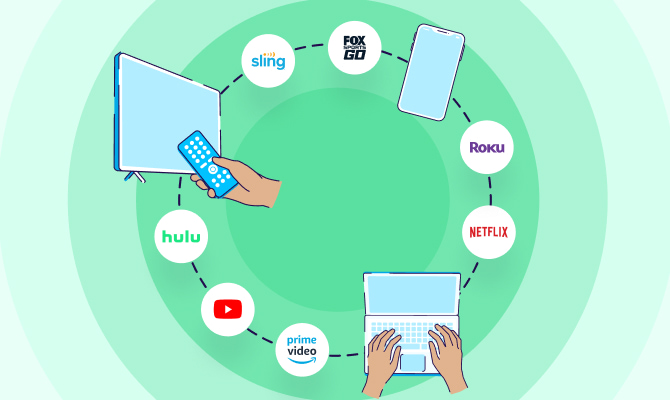
If you’ve ever binged a show on Netflix or talked to your sibling on Skype, then you’ve experienced OTT—media that was sent “over-the-top” of an existing cable line.
OTT streams content on TV, desktop, mobile, gaming consoles, and tablet devices through dedicated apps and websites. This means consumers don’t have to use a traditional content distributor to access their favorite programming.
With OTT:
- You choose how to consume. While traditional media requires dedicated set-top boxes or radios, OTT delivers media on your laptop, tablet, phone, smart TV, and more.
- You choose the time. Unlike traditional media, which is pushed out on a linear schedule, you can stream OTT content anytime and in any order you wish.
- You can still choose to flip channels. If you’re overwhelmed by the paradox of choice, digital content providers are now providing free ad-supported streaming TV, or FAST for short, which shows a linear broadcast schedule similar to traditional cable. The difference is that it’s monetized through programmatic ads, making it a part of the connected TV category.
- You choose the content. A traditional service provider had a program manager who decided, based on thorough research, which shows, movies, or songs they’d air. With OTT, you get to play any content from any media company’s app or website, based on your personal content preferences.
Additionally, media companies and marketers get a lot of direct feedback as users engage with programming and ads, guiding content production and advertising strategies.
Being over the top is not always a bad thing
OTT has completely changed the dynamic between media consumers and producers. In the traditional media model, a distributor like a broadcast network, radio station, or cable TV provider bundled content, and played it on a predetermined schedule. OTT, on the other hand, bypasses distributors so consumers can log in to a producer’s app or website and enjoy any piece of content they choose.
By cutting out the middleman, producers and marketers have a direct connection with their audiences, which is an incredible opportunity to personalize experiences while serving content that matches exactly what their audiences want.
OTT monetization models
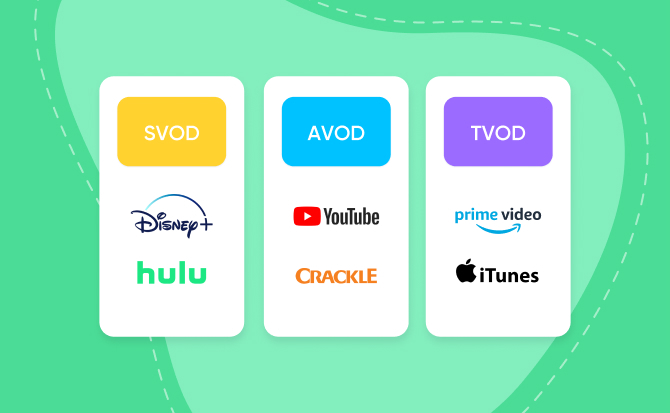
Money makes the world go round – and the world of OTT wouldn’t be possible without effective revenue models to fund it. Here are six ways publishers generate revenue.
1. Subscription video on demand (SVOD)
The SVOD model relies on monthly subscriptions for users to watch whatever they want for a flat monthly price. Apple TV+, Amazon Prime Video, HBO Max, Disney+, and Sky all use the SVOD model. Spotify, Apple Music, and Tidal also take this approach for music streaming.
2. Advertising-based video on demand (AVOD)
AVOD offers a freemium or discounted service, where the majority of the revenue is from ads. DailyMotion, Pluto TV, YouTube, 4OD, Crackle, Spotify, and Tubi use the AVOD model.
Broadcast video on demand (BVOD) is a subset of AVOD. It’s an ad-supported streaming service provided by traditional publishers, like NBCUniversal with Peacock.
3. Transactional video on demand (TVOD)
TVOD operates on a pay-per-view model. Consumers pay for each piece of content they want to watch or song they want to listen to. TVOD works especially well for sporting events, new film releases, and exclusive content.
4. Free ad-supported television (FAST)
As mentioned above, FAST primarily shows linear programming for free. These services — which include Pluto and Samsung TV Plus — are powered by ads and emulate the traditional TV experience.
5. Premium video on demand (PVOD)
In a PVOD revenue model, content publishers charge a premium fee for early and exclusive access to video content. The difference between PVOD and TVOD is simply the premium pricing. For example, Disney+ released films like Mulan for a $30 fee when it was first released, then released to the rest of the subscriber base after three months.
6. Hybrid
As the OTT space evolves, providers are beginning to experiment with multiple revenue models. We’ve seen this with Netflix and Hulu, which offer ad-supported tiers on top of a fully paid subscription. Meanwhile, Amazon charges a monthly subscription fee, but also has exclusive content that can be paid for.
Ultimately, OTT revenue models are flexible and adaptable to changing consumption patterns.
Ad formats
One of the greatest benefits of OTT advertising is the wide range of ad formats available to advertisers. Unlike traditional television, OTT ads can be served differently depending on the content being watched and the audiences being served.
Pre-roll ads: Brief ads shown before the video begins.
Mid-roll ads: Ads shown during a video, slotting into natural breaks to maximize user experience.
Post-roll ads: Ads shown at the end of the video.
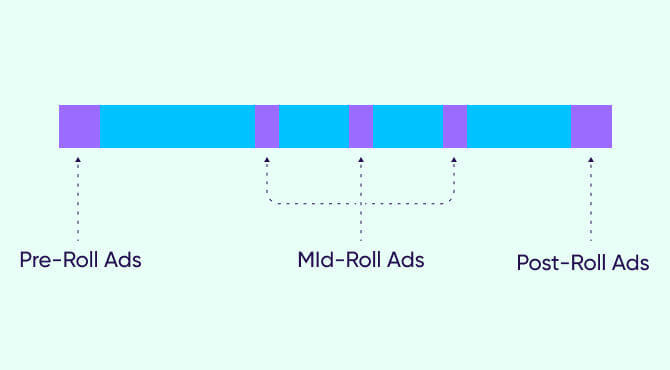
Picture-in-picture ads: Video ads shown in the corner while the main video is playing.
Interactive ads: Ads that ask viewers to engage with them via a link, survey, or game.
Companion banner ads: Banner ads that show alongside the main video content.
Out-stream video ads: Video ads that appear outside of the main video, including in-article, in-feed, or in-banner.
The benefits of OTT advertising
Money follows attention — and all the attention right now is on digital content. Although OTT advertising is still considered new, there are several reasons why it’s become an extremely effective form of advertising.
Precision targeting
OTT ads play when a single person streams a piece of content. That allows marketers to set niche audience targeting for attributes like interests, location, and demographics.
Compare this to traditional, linear broadcasting, where everyone in the audience sees the same ad as it airs during a program. At best, those traditional ads are targeted at city-sized geographic areas. That’s a lot of people viewing an ad who may never care about the product to begin with.
Engaged audience
The video completion rate for OTT ads hovers north of 80%. Why so high? In part, it’s because many OTT ads aren’t skippable. But even when they are, they’re more relevant to the viewer because of tighter targeting.
On the other hand, digital video recorders (DVRs) gave TV watchers the power to fast-forward through commercials, which helped fuel a trend where more than half of live TV viewers now say they skip every ad. Who said marketing was easy?
Better analytics
Each person who pulls a piece of OTT content from an app is an audience of one. That allows you to learn more about who sees your ads than when a large mass of people views them at the same time.
Also, many OTT ads are interactive. The viewer can click a link or choose an option. Their interaction gives you an insight into their preferences and can even get them into your marketing funnel for future retargeting campaigns.
Broadcast and cable media providers, on the other hand, can only tell you about the general demographics of the people watching their programs. As a result, it’s difficult to connect individual viewers to engagements with your brand.
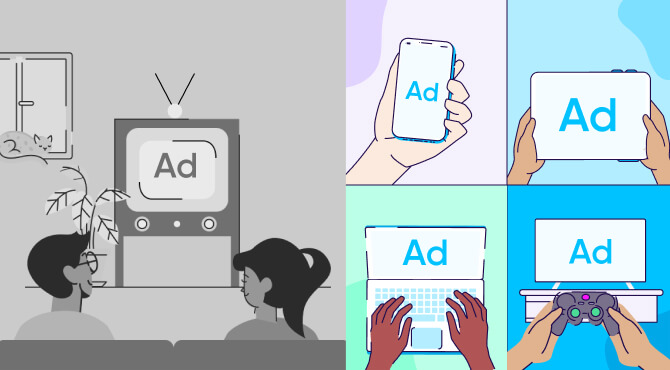
You don’t need IDFA
In a world with increasing data privacy changes, OTT advertising allows you to target specific audiences without bending the rules. OTT advertising provides valuable first-party and third-party data that can help advertisers place their ads accurately and in a timely manner.
What does the future of OTT look like?
In the near future, we’ll see more people with more devices using faster internet connections. Virtually every aspect of OTT shows signs of continued growth for years to come. Here’s why:
Growth, growth, growth
In short, more people are consuming OTT media.
With 5G technology slowly rolling out in every major city around the world, along with internet companies like Starlink, the growing internet infrastructure allows more people to enjoy high-quality content through their personal devices, whenever they want. Faster download speeds will not only deliver content to more people, but will continuously improve user experience.
An estimated 3.3 billion people will view an OTT video in 2025. The Asia-Pacific region in particular is projected to grow to 1.345 billion users in 2026.
Ad spend keeps expanding
Marketers are making bigger bets on OTT media while their investment in traditional channels stays flat. Spending on OTT video ads will almost double in the US from 2020 ($34 billion) to 2025 ($63 billion).
Podcast ad spending is headed in the same direction, estimated to surpass $2.5 billion by 2025. Broadcast TV ad revenue is predicted to remain stagnant at around $65 billion for the foreseeable future.
With more dollars pouring into the OTT pool, competition will get tighter and costs could rise — a signal to invest in OTT ads sooner rather than later.
More experimentation and self-service options
Netflix’s announcement of its ad-supported tier proved something of a PR nightmare (and meant similar announcements from other major platforms flew under the radar). But it signals that publishers are experimenting with different revenue models.
Hulu+ leads the charge with its robust self-service ad platform, which encourages more advertisers to spend. It’s only a matter of time until Disney+, Netflix, and HBO invest in more accessible digital ad products.
Key takeaways
- OTT (over-the-top) is the practice of delivering digital content online in place of traditional broadcast TV or cable boxes.
- OTT ads enable marketers to target niche audiences by attributes like interests, location, and demographics with great precision.
- There are five primary OTT advertising models: subscription video on demand (SVOD), advertising-based video on demand (AVOD), transactional video on demand (TVOD), free ad-supported television (FAST), and hybrid. Increasingly, platforms are experimenting with hybrid and self-service options.
- Advertisers can choose from a wide range of ad formats, depending on the content and audience.
- OTT is forecast to grow dramatically over the next few years, as audiences turn away from traditional media in favor of streaming, made possible by better internet infrastructure.

